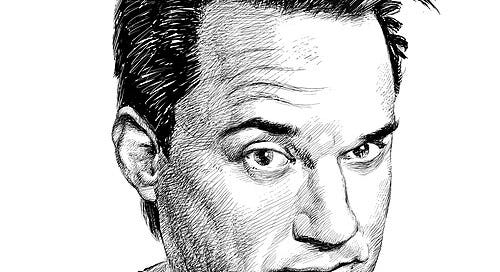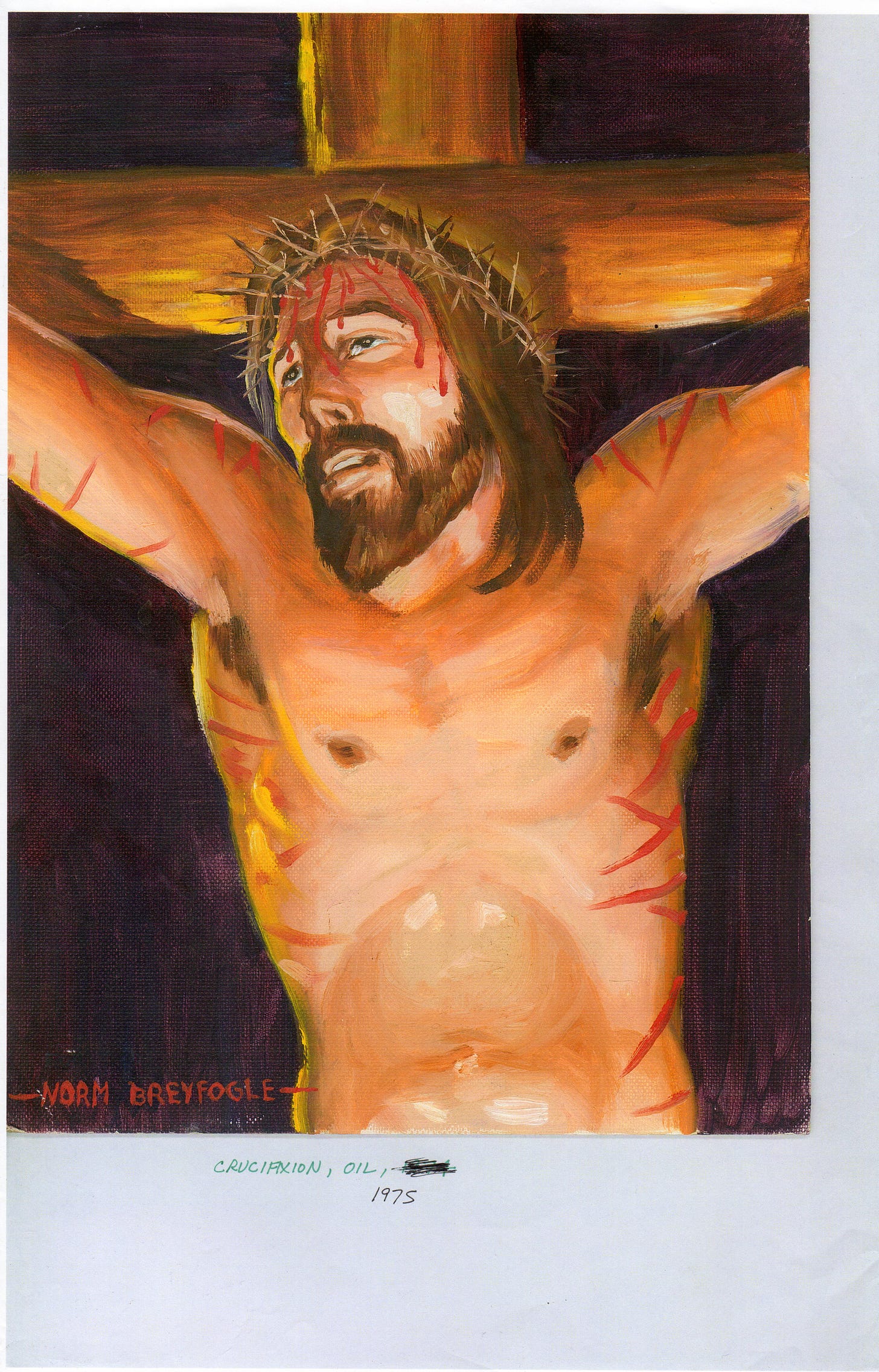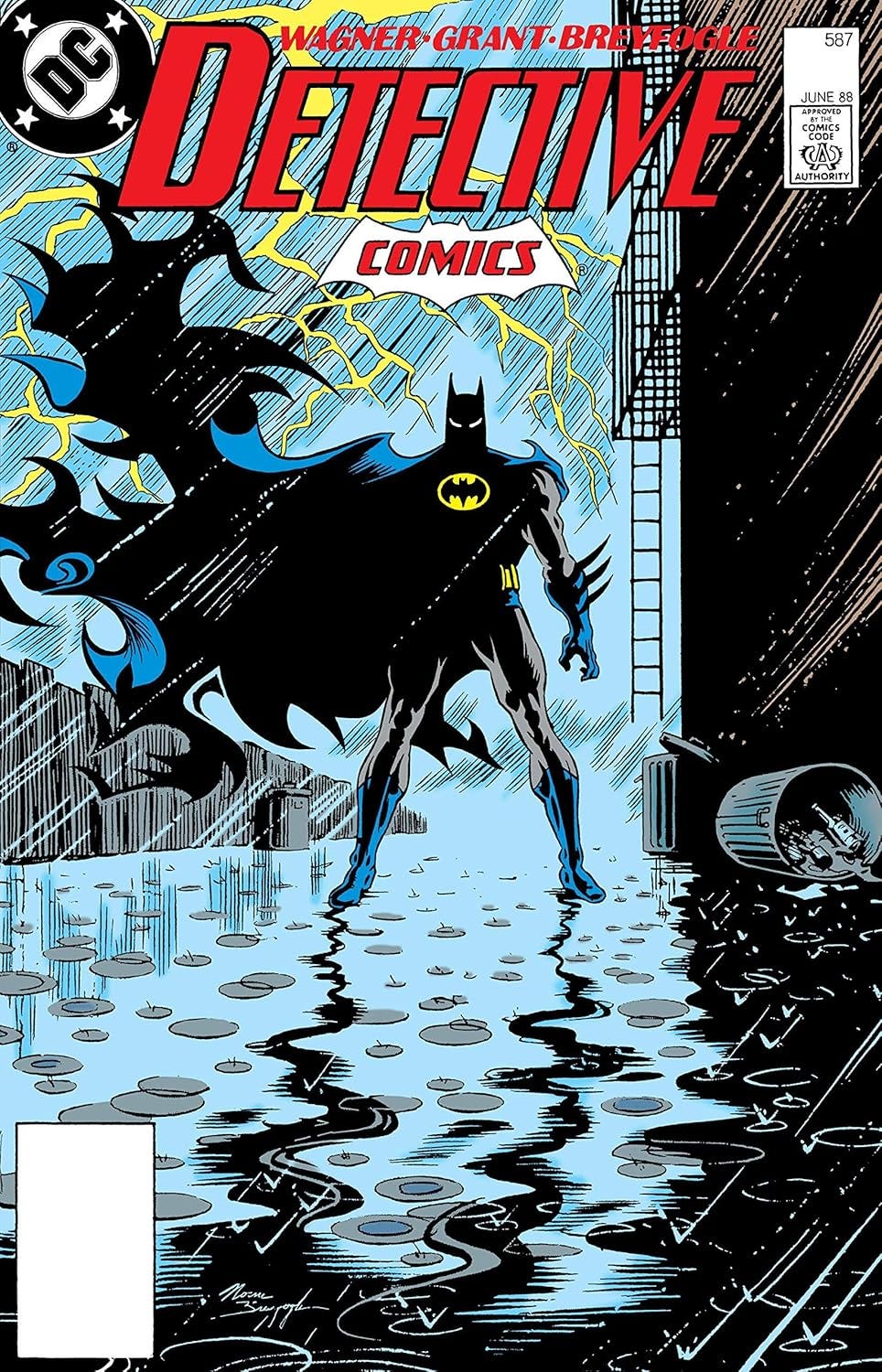Back in 2007, Norm Breyfogle and myself were talking, like we used to do, when he asked if I’d like to write his life story. I was interested, but suggested that I might be a bit too close to him to be objective. Norm thought that was a load of bullshit, and insisted that I was perfectly placed to get his life down properly, as I’d not only write the good but also the bad and indifferent.
I accepted. We called the project The Art of Norm Breyfogle. We never got around to locking down a proper title.
We spent the next few years talking each week, covering his life and career. These conversations were recorded at Norm’s request. I’d then transcribe the tapes, send them to Norm and he’d send back his edits. He’d often add more detail into the pages that came back.
Michael Netzer did a great illustration, that you can see above. Michael was gracious and offered us the drawing to use as a potential cover. I think we would have used it.
We had a publisher lined up. All was in place for the book to appear as a coffee table book, but the publisher went broke, owing a few people money. Then another publisher stepped in, but they ultimately decided that Norm wasn’t noteworthy enough for the project we had in mind. They were after a project no more than 15,000 words, consisting of interviews. Norm wasn’t happy with that, so we passed. A third publisher came along, but they were so bad we both passed (said publisher still owes me money, going back 20 years next year).
We kept at it though. Norm sent over photocopies and scans of his earliest art (which I will share). We used interviews and articles that Norm wrote, letters, faxes and more. The book was written and we back and forth, each adding, subtracting and editing. Then 2014 happened.
After the stroke, Norm fell into a pit of depression. We kept on with the book, and I contacted as many publishers as I could to get it out there fast, so Norm could get money from it. Still no luck. I suggested to Norm that perhaps I’d annoyed enough people that me being attached to the project was the problem. I took my name off it and Norm sent it out himself, as an autobiography. Nothing. As Norm said, it wasn’t me, it was them.
Norm messaged me in mid-September 2018 to tell me that he’d finished what he hoped would be his final edit, and that he’d not done much editing this time at all. Then silence. I found out why when I got a call early in the morning later that month.
Norm passed on before he could send the final edit back to me. I have the edit I sent to him, and it’s been with me ever since. I always felt that it was too raw a wound to go back to and finish. People have approached me since to publish it, but, it didn’t seem right.
I didn’t go back and finish it. In early 2018 Norm told me that he was leaving the rights to his writing, and his series Metaphysique, to me (I had bought the entire series of Meta[physique from him a few years earlier). I think he knew his time was short and wanted to get things in order. He wanted this book out there, for those who loved him and wanted to know what made him what he was.
So, here it is. I’ll publish the book on this forum over the next few weeks. Once it’s done, it’ll be out there as Norm intended. Norm was always open to people showcasing his work, as long as they gave the appropriate credits. I know he’d be right behind this one.
I still miss him. I find myself still talking to him, and I do feel that he hears me. I miss his wisdom and laughter. But, we will speak again.
Where do we start? Perhaps with the introduction.
In 2017, we decided that the introduction had to be written by Alan Grant. Alan accepted immediately and sent back a lovely tribute to Norm.
Let’s start with that.
Note: Please do not reproduce this work in full without asking. By all means, link, mention, take little bits here and there. This series will be free for all to read. It is copyright 2018 Norm Breyfogle and Daniel Best. Introduction copyright 2007 Alan Grant, and used with permission.
THE ART OF NORM BREYFOGLE
by Norm Breyfogle and Daniel Best
INTRODUCTION
by ALAN GRANT
Way back in 1987, when DC Comics senior editor Denny O’Neil asked John Wagner and me to write a trial Batman script, our first question was “Can we choose the artist?”
We’d been working for the British science fiction comic 2000AD and its many spin-offs for several years, and we were on good terms with dozens of UK artists. Dave Gibbons would do a great Batman, we figured. Or maybe Brian Bolland, who was already working on “The Killing Joke” with Alan Moore. Or - perhaps our first choice - Mike McMahon, who’d just been voted the UK’s top comic artist and was Bolland’s own favourite illustrator.
Denny quickly ended our speculation. “I have an artist in mind,” he told us, “a young guy called Norman Breyfogle. He’s been working on a book called ‘Whisper’, and he shows a lot of promise.”
Most writers prefer to know an artist’s work, so that scripts can be tailored to play to his or her strong points and avoid the weak points. But no samples of Norman’s art were available to us; we wrote the first two-part script “blind”, so to speak. It was several months before we saw the results - in Detective Comics *583/4 - when our copies arrived from DC.
Both John and I liked what we saw: Norman’s version of the villains of the piece, The Ventriloquist and Scarface, was exactly as we’d envisaged. One other point - which seemed slight at the time - impressed us: the way that Norman made Batman’s cape seem almost like a living thing.
Norman did an even better job on the follow-up story, “The Ratcatcher.” In fact, it was Norman’s cover for ‘Tec *586 which first really alerted me to the fact we were working with someone way out of the ordinary. That cover was so potent: Batman lying in the sewer at the mercy of the mysterious villain...with hundreds of pairs of rat eyes peering from the gloom. It sent a shiver down my spine...and I like rats!
Preferring to work on his own creation, Judge Dredd, John Wagner dropped out as my co-scripter after ‘Tec *590. In a strange, long-distance kind of way, Norman’s and my thoughts and visions really began to mesh; it was the start of a long working partnership, and a friendship that still endures today.
What makes a great comic artist? I figure it’s a blend of a number of talents. First, he has to be able to do eye-catching covers; check out Norman’s work on ‘Tec *587 or *591 (the framed original hangs on my office wall), or Robin’s surprise appearance on the cover of Batman *457. Secondly, it helps if he can do arresting, off-the-wall splash pages - as Norman did with virtually every issue. One of my favourites is the Eisner-esque “Trash” from ‘Tec 613.
Next comes the ability to create memorable new characters - and Norman must have created more than virtually any other Bat-artist. The Ventriloquist and Scarface, the Corrosive Man, Cornelius Stirk a.k.a. The Fear, Kadaver, Mahakala, the new Clayfaces...the list goes on and on, characters who are still as fresh and impressive today as they were when he first created them. My own favourite is the teenage hero/villain Anarky; he looked so good, DC even gave him his own monthly book. (I should also mention here that Norman transformed Gotham City itself into a “character”. His expressionistic take on the city, combined with his exceptional use of light and shade, turned Gotham back into the frightening nightmare first envisaged by Bob Kane.)
Fourth comes the ability to convey movement and emotion. There is no dispute that Norman’s art is among the most dynamic to have appeared in any comic, ever; and he’s one of the very few artists who have been able to successfully portray both Batman’s humanity and his (apparently) superhuman powers.
Finally, and perhaps most importantly, the truly great comic artist must be able to tell the story. Sounds obvious, I know, but I’ve lost count of the “great” artists I’ve worked with who weren’t really able to pin down this most fundamental part of their job. In Norman’s hands, storytelling is a delight to see, as his art flows from panel to panel like molten honey (or, perhaps more aptly, red-hot lava). And it’s not just the dynamics of the panel that concern him, but the dynamics of the entire page; this aspect of Norman’s work is matched only by a few of the all-time greats, Will Eisner foremost among them.
In the 70 or so years since Batman’s creation, the Dark Knight has been drawn by literally hundreds of artists. I may be biased, because I wrote the stories for him, but in my humble opinion Norman Breyfogle is the best of them all.
--Alan Grant, Scotland 2007
Next: Growing up Norm!








Followed your work for a long time at the old blog, Dan and I will be sure to follow this
Is print on demand an option?